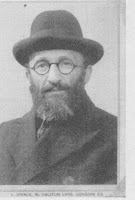Rav Simcha Zissel Ziv, the Alter of Kelm
At least once a week a person must practice the concept that actions speak louder than words.
Category Archives: Kelm
My role as a pick-up artist
I often find myself picking up candy wrappers, seforim, and the occasional napkin or fork during kiddush on Shabbos. At times, I’ve even, with a simple greeting of, “Good Shabbos Kodesh”, picked up the ears of those that I pass in the street. I make a point to also pick up garbage in front of an inside my children’s day school when I am there, as well. It is an issue of Kavod HaTorah. The Holy Hunchback, I’m not, but I try.
In Kelm the talmidim fought for the coveted position of being able to clean the Talmud Torah of Kelm and even to take out the garbage (usually a job for the oldest bochruim).
My kids know that if they are walking though shul with me and see a Dum Dum wrapper on the ground that either I’ll pick it up myself or ask them to. They don’t mind picking it up, because were they not there, they know that I’d be the one throwing it away.
I cannot stop people (usually kids) from carelessly throwing candy wrappers on the ground. However, I can make sure that the shul where I daven is fairly clean, if newcomers, guests, or non-observant Jews come by.
Sunday’s kernel from Kelm
Constantly bear in mind hte favors people have done for you, remembering their positive qualities and not their faults. One who follows this path will be beloved by all.
-Rabbi Simcha Zissel Ziv, the Alter of Kelm
Sunday’s Spark of Mussar
Rav Simcha Zissel Ziv, the Alter of Kelm
Either one invites and receives guests, or one is reduced to becoming a guest.
From Sparks of Mussar by R Chaim Ephraim Zaitchik
Sunday’s Spark of Mussar
Rav Simcha Zissel Ziv, the Alter of Kelm
“Either one invites and receives guests, or one is reduced to becoming a guest.”
From Sparks of Mussar by R Chaim Ephraim Zaitchik
The Alter of Kelm on Ki Sisa
The following was sent to subscribers of R Zvi Miller’s Salant Foundation email list:
THE SAGES OF MUSSAR ON THE PARSHA: KI SISA
HaShem selected Betzallel to form the vessels of the Mishkan, i.e., Tabernacle. However, the criterion to serve as the “chief artisan” was not based on his artistic ability. Rather, HaShem selected Betzallel because he had “a good name.”
In light of this the Midrash cites the verse (Kohelles 10:1), “Dead flies putrefy the fragrant oil, whereas a good name falls on a corpse and does not putrefy.” This poetic verse cries out for an explanation! Moreover, what possible application can we draw to Betzallel from the concept of “a good name falling on a corpse?”
Rather, the verse metaphorically uses the terms “fragrant oil” and “a good name” to depict two divergent types of people in relationship to the performance of Mitzvoth.
“Fragrant oil” refers to a person who suppresses his negative impulse in order to perform a good deed. For instance, Shimon is miserly by nature. Therefore, in order to fulfill the Mitzvah of tzedakah (charity), he consciously forces himself to give to others. HaShem recognizes his struggle and merits him accordingly.
However, the inner conflict impedes him from giving generously and joyously. As a result, he does not find much favor in the eyes of the community. Resultantly, his Mitzvoth are like fragrant oil, putrefied by dead flies, i.e., his unrefined character traits.
Whereas, a “good name” refers to a person who has rectified his character to pure goodness. Through the combination of his excellence of character and the Mitzvoth that he performs, he faithfully and graciously serves his community.
In this light, “a good name falls on a corpse and does not putrefy.” That is, even when he performs Mitzvoth that might awaken base character traits, his goodness is constant and absolute.
Betzallel transformed himself. That is, he was filled with compassion and kindness, and had no inner harshness, whatsoever. The Mishkan was the place where HaShem revealed His compassion and forgiveness. Therefore, HaShem chose Betzallel, to assemble His holy dwelling place on earth, amongst the Children of Israel.
[Based on Ohr RaShaz of the Alter of Kelm]
Sunday’s Spark of Mussar
Rabbi Simcha Zissel Ziv,the Alter of Kelm
“Nothing in nature is perfect; everything requires correction.”
The Alter of Kelm on Darwin
“”Had he seen my teacher, Rabbi Yisrael Salanter, who developed his character traits to a degree of perfection that fully expressed the essence of the Divine Image, he never could have entertained the possibility that human beings evolved from monkeys,” said the Alter.
Sunday’s Spark of Mussar
Rav Simcha Zissel Ziv, The Alter of Kelm
When R’ Simcha Zissel learned Mussar, his whole body was involved. He would pace back and forth singing penetrating, heart-rending melodies that touched the soul and awakened the mind. He himself composed the tunes.
From Sparks of Mussar by R Chaim Ephraim Zaitchik
55th Yartzeit of Rav Dessler
Sunday morning, the day of the levayah [for his wife], Rabbi Dessler was found polishing his shoes. Rabbi Dessler explained, “She was always meticulous that my clothes shoudl be spotless before I left the house, and now I’m fulfilling her will.” (based on a page 340)


